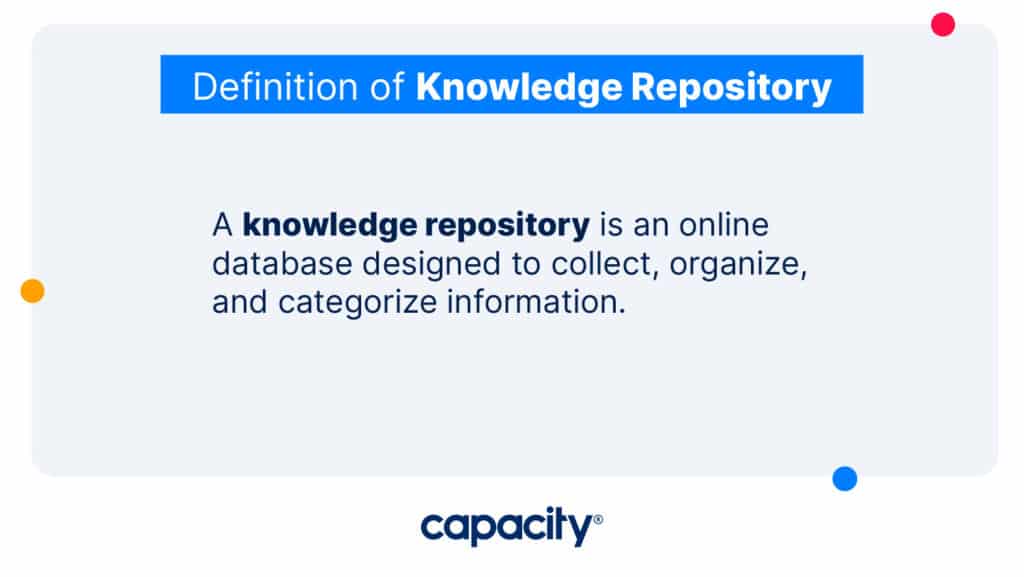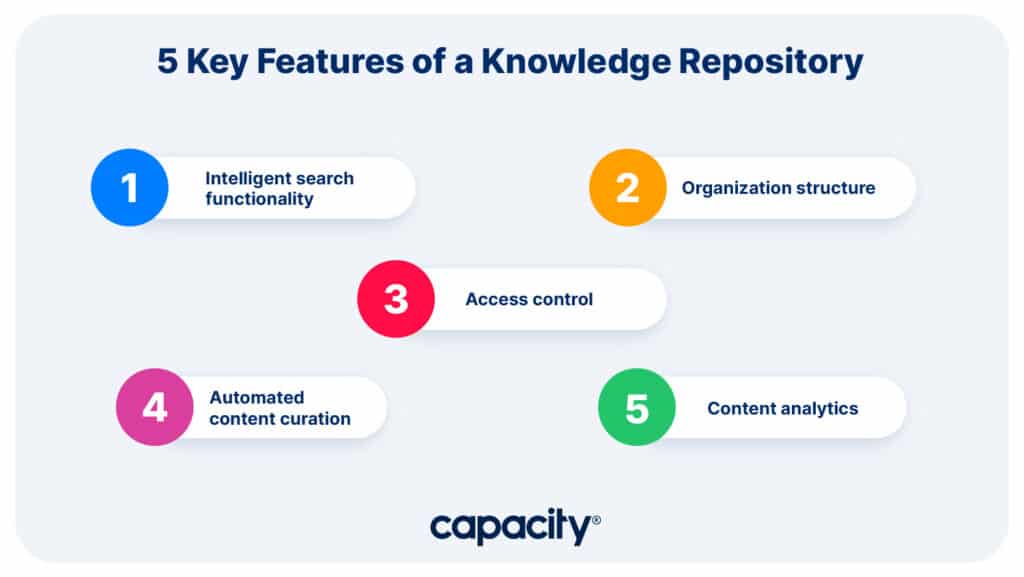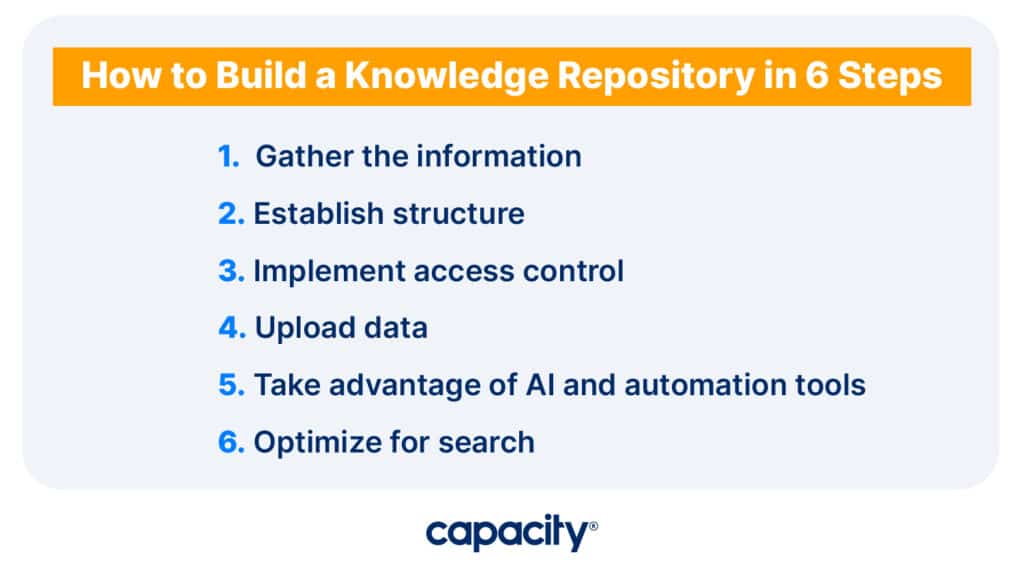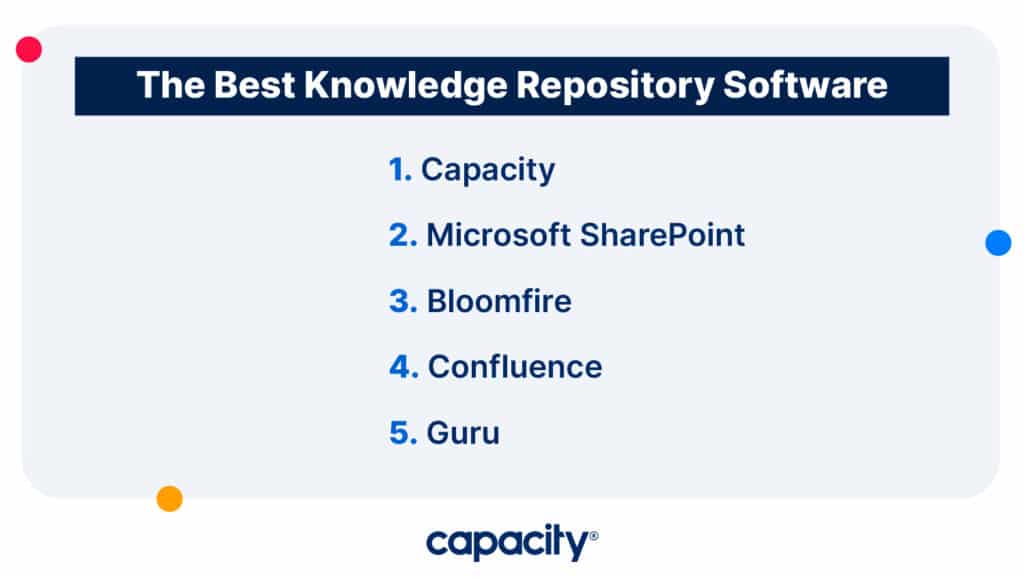Are you ready to take your knowledge management to the next level with AI and automation? Did you know that, on average, employees spend 1.8 hours every day—9.3 hours per week—searching for information? Building a robust knowledge repository for your business helps you stay organized. But it also can work wonders to improve your efficiency and customer service.
Have a knowledge repository that works like a charm with the right strategies and tools. This article will show you how to make it happen. From developing an initial plan to using AI and automation, let’s explore how you can build the perfect knowledge management repository.
Having an impactful knowledge base can make all the difference – so let’s dive into how to create one!
What is a knowledge repository?

A knowledge repository is an online database designed to collect, organize, and categorize information. Organizations use these repositories to manage their internal or proprietary data. But you can also use them for external customer support solutions.
Having a knowledge repository is critical to long-term success in any organization. A knowledge base provides a centralized location for employees, customers, and other stakeholders to access the information they need – fast. With it, you can create organizational memory. With a knowledge base, current employees benefit from the learning of past employees.
This structured access to data drives efficiency so you can manage customer relationships. Then, with AI and automation, you can streamline the process of managing a knowledge repository. Automation helps to provide more accurate search results and faster response times. With an effective knowledge management repository, you can realize the full potential of your data.
What are the key features of a knowledge repository?
Knowledge repositories can transform the way a company handles information management. Before you start building a knowledge base, let’s review a few of the main features of a knowledge repository:

Intelligent search functionality
Searching for information in a knowledge repository can be like finding a needle in a haystack. That’s where intelligent search functionality comes in. It not only saves you time and frustration. But it also helps you discover relevant content that you may have never found otherwise. Intelligent search can suggest related topics and even learn from your search history to personalize your results.
This feature allows users to find the information they need using natural language search terms. AI-powered search engines can learn from historical user data to become more accurate over time. With intelligent search, you get better results with less effort.
Organization structure
A well-designed repository will have distinct categories and subcategories. This structure helps users to navigate the content hierarchy.
Organizational structure is crucial when it comes to building a comprehensive knowledge repository. It creates a clear understanding of how information is organized and accessed. Then, it streamlines the process of finding the information you need.
Take this example: Imagine having an extensive library without any structure or system to categorize the books. Finding the information you’re looking for would be a grueling and frustrating experience. We love the Dewey Decimal System for a reason! With an organized library, you can navigate the shelves and find the exact book you need in moments. The same principle applies to a knowledge repository. An organized structure is crucial, allowing users to quickly find information. Without it, the repository becomes a maze, making finding the correct information impossible.

Streamline Complex Processes Instantly
Capacity’s AI and automation technology can help:
- Answer FAQs anytime, anywhere
- Find relevant documents within seconds
- Give surveys and collect feedback
Access control
Different user groups may need different access levels to the repository for security purposes. A practical knowledge management system should provide various permission levels that can be assigned to individual users or user groups.
This feature ensures that sensitive information is secure. It allows you to control who can see and edit specific data. This flexibility enables organizations to create a repository that meets their particular requirements.
Automated content curation
Automated content curation is the process of managing and organizing content within a repository. With this feature, ensure that the most relevant information is easy to access. This feature allows organizations to keep their knowledge base up-to-date so only the most reliable data is presented.
For example, when Capacity’s AI chatbot doesn’t know an answer, it creates a helpdesk ticket for you. Then, the reply will instantly be added to the intelligent Knowledge Base for the next time a user needs that piece of information.
AI automates content curation by analyzing past user behavior to personalize results. Automated curation can significantly reduce the time and effort required to maintain a knowledge repository. With it, you can be free to handle more strategic tasks.
Content analytics
It’s important you maximize the value of your knowledge repository. Content analytics is the key to unlocking the full potential of your database. It helps you understand the most searched, viewed, or shared content.
With this data, optimize your content to make it more usable and relevant. Drive better engagement for your audience with analytics. It also helps you identify knowledge gaps and uncover areas that need improvement. But that’s not all. Content analytics can also help you track the performance of your organization’s intellectual capital. It’s not just about analytics. It’s about turning data into insights that can shape your organization’s future.
How AI and automation impact knowledge repositories
In a world of limitless information, it can be daunting to keep track of all the knowledge we take in on a daily basis. That’s where AI and automation come in. They make organizing and retrieving information so much easier. AI and automation are revolutionizing the way businesses manage their knowledge repositories.
Instead of sifting through heaps of data, we can work with machine learning technology in new ways to categorize and connect pieces of knowledge. This saves time and helps us gain new insights and connections that we might have missed otherwise.
In short, AI and automation have the power to transform a business’s knowledge base into a valuable asset. With a knowledge repository, gather real insight into your organization’s operations.
How to build a knowledge repository in 6 easy steps
It’s time to create your knowledge repository! *cue the confetti*

1. Gather the information
The first step in creating a knowledge repository is to gather all available information and data related to your organization’s goals and objectives.
Here are some items to consider including in your knowledge base:
- Company information
- Customer feedback
- Industry news
- Training materials and manuals
- FAQ documents
- How-to guides
- Troubleshooting solutions
- Video tutorials
2. Establish structure
Once you have gathered the information, you must establish a structure to organize it. Decide on categories or topics to help users navigate the content hierarchy efficiently. You may also want to create subcategories or tags within each topic that are more specific to certain pieces of information.
3. Implement access control
When it comes to managing a knowledge repository, access control is crucial. Determine who can view, edit, or add information to the repository. Then, limit the visibility of certain pieces of data when necessary. Set the ground rules for how the repository should be used to ensure everyone follows the same rules.
4. Upload data
Next, you have to upload the information into your knowledge repository. Double-check each piece of information so it’s accurate, up-to-date, and properly categorized.
Information is constantly changing in businesses. This is why platforms like Capacity make managing hundreds of data points a breeze. Capacity can intelligently surface stale content, making for easy improvement. And, whenever multiple answers to a single question are found in the knowledge base, Capacity provides alerts to verify which answer is correct. We could go on and on! Learn more about Capacity’s Knowledge Base here.
5. Take advantage of AI and automation tools
Streamline the process of managing your knowledge repository with AI and automation. Find an AI-powered support platform that can help users quickly find the necessary information. Hint: We list a few great companies below.
Automated content curation will also ensure that only the most relevant and up-to-date content is available. One example is Capacity’s AI chatbot. The chatbot will create a helpdesk ticket when it doesn’t know an answer. And after you answer, it adds the reply to the knowledge base.
6. Optimize for search
We’re in an age of information overload. So, having a knowledge repository is essential to keep track of valuable insights and resources. But what good is a repository if it’s not accessible? That’s where search optimization comes in.
By optimizing your repository for search, you’re not just making it easier to find relevant information. You’re also making it more discoverable to those who may not even know it exists. Think of it as making your secret stash of knowledge less secret and more inviting. By adding keywords to titles and descriptions, users can find new content real quick.
It’s time to create a comprehensive and effective knowledge repository. You’ll reap the benefits for years to come.
The best knowledge repository software
There are a lot of cool features available out there: AI-powered search engines, automated content curation, and more. Plenty of solutions can help you make the most of your knowledge base.

Here are some of the best tools to consider when building a knowledge repository:
Capacity
Capacity is an AI-powered knowledge management platform that helps teams find answers and deflects tickets away from support teams.
Additionally, pros include intelligent search capabilities, automated content curation, real-time analytics, and an all-in-one platform. Cons include a steep learning curve. But they don’t leave you hanging. There are loads of resources available for onboarding and ongoing support.

Streamline Complex Processes Instantly
Capacity’s AI and automation technology can help:
- Answer FAQs anytime, anywhere
- Find relevant documents within seconds
- Give surveys and collect feedback
Microsoft SharePoint
SharePoint is a cloud-based collaboration platform that offers extensive customization options.
Pros include ease of use, powerful search, and robust document management. Cons include a higher cost and a complex setup process.
Bloomfire
Bloomfire is a knowledge-sharing platform. With it, teams can store and share information quickly and easily.
Pros include its intuitive design and seamless integration with popular business tools. They’re also known for excellent customer service. Cons include limited customization options and no free plan.
Confluence
Confluence is a cloud-based collaboration platform. It’s designed to help teams store and access information quickly and easily.
Pros include powerful search capabilities, remote collaboration, and an intuitive user interface. Cons include a lack of customization options and limited integrations with other applications.
Guru
Guru is a knowledge management platform that helps teams create, share, and access information.
Pros include automated content curation, powerful search capabilities, and seamless integration with popular business tools. Cons include limited customization options and no free plan.
How Capacity can help streamline knowledge management
Capacity is the perfect platform to streamline knowledge management for businesses. With its powerful AI-powered search capabilities, Capacity helps organizations quickly find information. And with automated content curation, keep your knowledge base up-to-date and accurate. Capacity also provides real-time analytics. Use analytics to track the performance of your intellectual capital.
Capacity’s intuitive user interface makes navigating the categories and subcategories easy. With Capacity, guide your users to the answers they need in moments. Ultimately, Capacity simplifies knowledge management, leaving you free to focus on your goals.
What are you waiting for? Try Capacity for free today!





